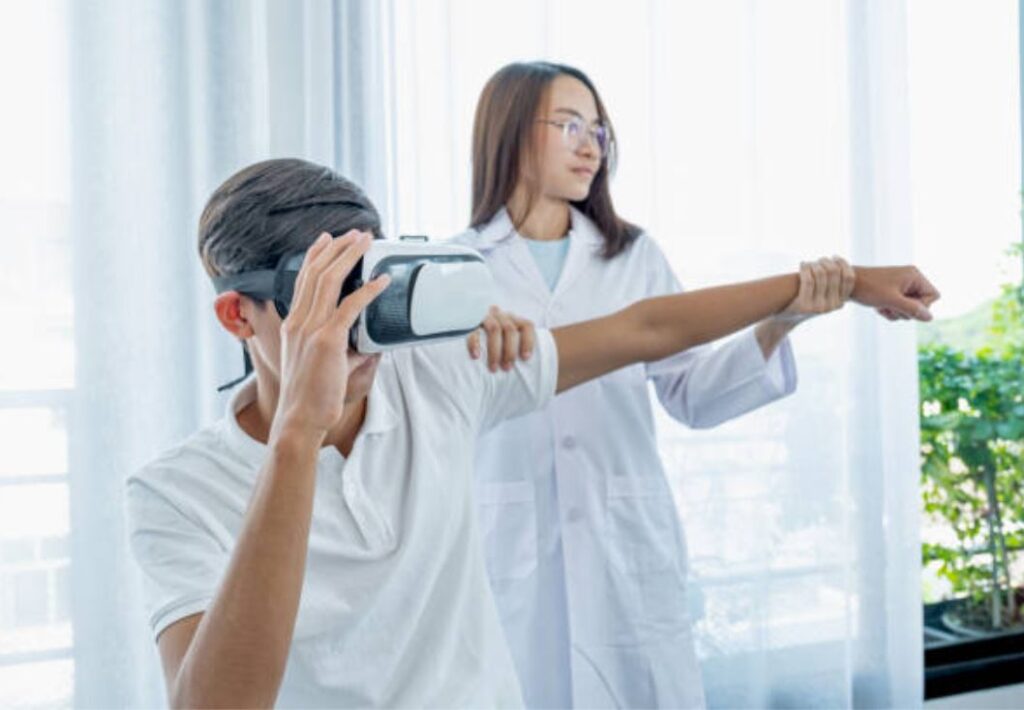La réalité mixte en rééducation des membres inférieurs par Dr Frank Wein
Nowadays, many professionals and companies use the terms virtual, augmented and mixed reality, which shows a...


Today, the healthcare system is always on the lookout for new technologies to advance research. Virtual reality combines simulation, learning and immersion of the user, while offering a strong interactivity close to reality.
When using virtual reality in your rehabilitation sessions, the patient lives an immersive experience : it increases his motivation, his concentration and his efficiency. As a real complementary tool to conventional rehabilitation, it is totally possible to integrate it into your sessions, but how? To treat which pathologies? At what pace? Discover how to use virtual reality in your rehabilitation sessions.
First of all, it is important to know that a first session with the use of virtual reality serves as an evaluation for the health professional, in order to be able to estimate the functional capacities of his patient.
We recommend virtual reality in rehabilitation for several pathologies, such as neurology (stroke, head trauma, MS ...), orthopedics / traumatology(post-operation, injury, fracture ...) and geriatrics (balance disorders, stimulation and maintenance of abilities ...).
Let's take the case of a patient with hemiparesis, motor disorders of an upper limb and balance problems. The healthcare professional selects a virtual reality exercise to help the patient work on his balance, and chooses the H'ability " Foot " universe. The patient works on support, amplitude and stability, with the aim of stopping the soccer ball like a real goalkeeper.
At the beginning of the first exercise of the session, the health professional enters the observation phase : how does the patient react? How does he/she work his/her amplitudes during the exercise? What pain did he feel during the session?
Thanks to this first use, he will be able to determine which parameters, options and levels of difficulty to set up for his patient: modification of the speed of the ball, realization of the exercise only with the use of the right hand, appearance of the ball only on the left zone, different placement of the patient (in squats position, lunges...) In this way, the exercise can be carried out in a modular and adaptable way, while identifying what needs to be reworked for the next sessions. To help with the configuration, information sheets are available for each exercise, explaining the modifications according to the chosen parameters.
A virtual reality rehabilitation session lasts an average of 15 to 30 minutes and is composed of 2 to 6 different exercises, depending on the intensity set and the patient's fatigability.
At H'ability, we place patient well-being and motivation at the heart of our developments. Equipped with a library of varied exercises, we offer you exercises that correspond to your patients' needs and objectives: upper limbs, prehension, balance, visual exploration, pronosupination...
Virtual reality sessions can be carried out wherever you like: in the office, on a technical platform, or in the patient's room, so that rehabilitation can begin as soon as possible if the patient is isolated or bedridden. Virtual reality comes to the patient, not the other way around.
The therapist can accompany the patient and guide him/her with the visual feedback from the helmet. He or she can also leave the patient to his or her own devices, provided safety precautions are respected.
Ultra-compact solution, the helmet is stored in its carrying case, making it practical and transportable everywhere. It can be brought by therapists during in-home sessions with patients.
Virtual reality exercises are safe and accessible to a large number of patients. It also helps fight kinesiophobia and improve physiotherapy. It reinforces and completes conventional rehabilitation, while expanding the field of possibilities!
Would you like to learn more about the benefits of H'ability virtual reality in rehabilitation?
Nowadays, many professionals and companies use the terms virtual, augmented and mixed reality, which shows a...
Nowadays, many professionals and companies use the terms virtual, augmented and mixed reality, which shows a...
Nowadays, many professionals and companies use the terms virtual, augmented and mixed reality, which shows a...
H'ability at Rééduca 2025 From October 9 to 11, 2025, join us at Paris, Porte de Versailles, stand C06,...